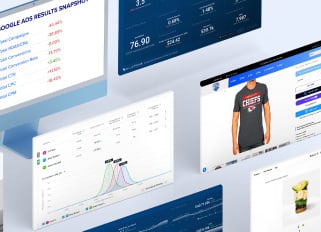
The Ultimate Guide for E-Commerce Sellers: How to Audit a Google Ads Account Like a Pro
Navigating the digital marketplace can be daunting for e-commerce sellers, especially when maximizing the potential of Google Ads campaigns. A strategic audit of your Google Ads account is more than just a routine check-up; it’s a powerful tool to ensure your ads are performing at their best, your budget is wisely spent, and your growth opportunities are identified and tapped into.
This ultimate guide is designed to equip e-commerce sellers, digital marketers, and small business owners with the skills to audit their Google Ads accounts like seasoned professionals. By following this comprehensive guide, you'll gain valuable insights into optimizing your account structure, your advertising strategies, and boosting your online presence.
What Is Google Ads Audit, and Why Does It Matter?
Before delving into the intricacies of auditing a Google Ads account, it's important to grasp its significance and purpose. A Google Ads account audit involves a comprehensive analysis of your account's performance, structure, settings, and search engine optimization (SEO) issues, along with other elements that may affect the success of your ads. This process not only highlights areas for improvement but uncovers potential challenges and growth opportunities.
In the competitive landscape of e-commerce, every dollar counts, and an audit can reveal inefficiencies that might otherwise go unnoticed. Research by WordStream indicates that businesses waste approximately 25% of their Ads budget due to mismanagement, highlighting the critical need for regular Google ads audits to ensure financial efficiency. These audits are vital for managing ad spend, enhancing ad performance, and discovering new growth avenues.
 What to Look for During an Ad Audit
What to Look for During an Ad Audit
It's important to consider a few key elements when performing a Google Ads audit for your online store. These include:
Keyword Selection
Start by analyzing the keywords currently in use in your ads and on your website. Tailor these keywords to your e-commerce company's target audience. This involves researching both short-tail keywords (often more competitive) and long-tail keywords (ideal for niche targeting) to create effective ad campaigns.
Evaluate Individual Ad Campaigns
After identifying relevant keywords, assess the performance of each ad campaign. Focus on key metrics such as click-through rates (CTR), cost per click (CPC), and other key performance indicators (KPIs) to evaluate how well each ad generates new leads.
Budget Allocation Strategies
Examine your budget allocation strategies across all your digital marketing campaigns—including Google Ads, Facebook Ads, remarketing, and others—to determine if they are driving sufficient conversions.
Analytics Tracking
Review your analytics tracking methods, like UTM codes for specific campaign data and event tracking pixels for measuring user engagement. Ensure these are properly configured to collect accurate data.
Creative Elements Review
Lastly, evaluate the creative aspects of your ads, including copy, images/videos, and overall presentation. Ensure that these elements are consistent with your brand's messaging and values.
Step-by-Step Guide to Conducting a Thorough PPC Audit
Conducting a PPC audit can seem daunting, whether you're a first-timer or someone who has experience but feels there’s room for improvement. This comprehensive step-by-step audit process will help you evaluate the key components and optimize your results.
1. Check Your Account Setup
Begin your audit by confirming that your account setup and tracking configurations are accurate. Verify the integrity of tracking URLs, conversions, goals, UTM parameters, and all tracking components. Additionally, ensure that your site tracking operates smoothly, with all data being recorded precisely.
Consider the following questions when checking:
- Are the conversion tags firing as they should?
- What data is missing from your tracking?
- How can we enhance our data capture for the information that isn’t currently being recorded?
2. Check Your Campaign Settings and Targeting
Next, examine the campaign settings to ensure the objectives align with your business goals and that the campaign type suits your e-commerce needs. Review targeting settings—geographic locations, languages, and device preferences—to ensure they reflect your target audience.
Ask yourself:
- Have all campaigns been correctly targeted?
- Are any campaigns using outdated targets that are no longer valid?
- Do these target settings reflect our ideal customer's profile?
3. Evaluate Budget Allocation and Bid Strategies
Determine whether your campaign spending is appropriate and if the budget distribution is optimal. To do this start by considering how much you have spent in comparison to what was allocated and evaluate if it aligns with your business goals. Be sure to also analyze bidding strategies, such as manual bidding or automated bidding options like Target CPA or Maximize Conversions.
Consider the following questions:
- Are we allocating our budget effectively?
- Is there room for improvement in our bid strategies?
- Would switching to automated bidding improve our results?
4. Analyze Keyword Performance
Examine your keyword performance closely to identify any inefficiencies. Pay attention to click-through rates, cost per click, quality score, impression share, and other key metrics. Create a negative keyword list to avoid wasting ad spend on underperforming keywords, and consider pausing or adjusting bids on them. Don’t forget to utilize tools like Google Keyword Planner and Ahrefs Explorer to enhance your analysis.
Also, consider the performance of branded keywords, exact match keywords, and broad match keywords in your strategy..jpg?width=600&height=400&name=close-up-of-hands-of-man-on-a-laptop-working-hard-2023-11-27-05-35-01-utc%20(1).jpg)
Reflect on these questions:
- Do we have any low-performing keywords?
- How can we improve our quality score for specific keywords?
- Should we invest more in high-performing keywords?
5. Check Ad Formats and Campaign Types
As part of your audit, assess the performance of different ad formats and campaign types. Evaluate standard text ads, image ads, video ads, responsive search ads, and dynamic search ads to see which are most effective for your e-commerce business on the search network. Consider running A/B tests on different ad formats to determine which performs best.
Think about these questions:
- Are certain ad formats performing better than others?
- How can we optimize our current ad formats for maximum impact?
- Is it worth investing in new types of campaigns (e.g., Google Shopping or remarketing)?

6. Evaluate Ad Groups
Ad groups are essential elements of your campaigns, allowing you to organize your ads by themes or target product categories. Start by ensuring that each ad group is narrowly focused on a specific set of keywords, which enhances ad relevance and improves quality scores. It's important to include multiple ad variations within each ad group level to enable effective A/B testing.
Moreover, the performance metrics for each ad group, such as click-through rates, conversion rates, and overall cost efficiency, should be regularly assessed. Reflect on whether your current ad group structures accurately represent the products, services, or themes relevant to your e-commerce business.
During your evaluation, consider the following questions:
- Are ad groups appropriately segmented, or is there unnecessary overlap?
- Are there opportunities to create new ad groups for emerging products or niches?
- Is each ad group optimized with relevant ad copy and landing pages that align with user intent?
7. Review Ad Copy and Creative Elements
Evaluate the visual aspects of your ads, including images/videos and ad copy. Ensure they are consistent with your brand's messaging and values. Analyze the performance of different ad copy variations to identify which resonates best with your target audience.
Consider the following questions:
- Are our ads visually appealing and on-brand?
- Which ad copy variations have performed the best?
- Is there room for improvement in our ad creative elements?

8. Look at Your Quality Score and Ad Rank
Quality score and ad rank are important metrics to monitor for the success of your PPC campaigns. Quality score measures how well your ads, keywords, and landing pages align with user intent, while ad rank determines where your ad appears in search results.
Take note of these questions:
- How can we improve our quality score?
- What factors contribute to our ad rank?
- Are there any competitive advantages or disadvantages that affect our ad position?
9. Analyze Landing Pages
Review the landing pages associated with your ads, ensuring they are optimized for conversions and align with user intent. Evaluate page load times, visual design, and call-to-action placement on these pages. Use tools like Google Analytics to track bounce rates and conversion rates for each ad and landing page.
Think about these questions:
- Are our landing pages relevant to the ads that lead to them?
- Do they have a clear call to action?
- How can we improve our landing pages to increase conversions?
10. Monitor Ad Extensions
Ad extensions allow you to expand the information displayed in your ads and drive more engagement from potential customers. Review your current ad extensions and their performance to determine which ones are most effective for your e-commerce business.
Consider the following questions:
- Are our ad extensions being utilized effectively?
- Can we add or remove any extensions to improve our ad's visibility and impact?
- What types of extensions are most effective for our business?
11. Track Conversion Rates and ROI
Finally, track conversion rates and return on investment (ROI) for your ad account after each campaign. Use this data to evaluate campaign performance and the success of your ads, making necessary adjustments for continuous improvement. Reflect on these questions:
- How have our campaigns performed in terms of conversions and ROI?
- Which campaigns have yielded the best results?
- Are there areas where we can adjust or reallocate the budget for better returns?
Incorporating effective conversion tracking is essential for maximizing outcomes!
12. Create an Optimization Plan
Utilizing your analysis of keyword performance, ad formats, ad groups, ad copy, creative elements, quality scores, ad ranks, landing pages, ad extensions, and conversion rates/ROI to develop a comprehensive optimization plan for your PPC campaigns. This plan should outline targeted actions to enhance the overall effectiveness of your ads and yield improved results.
Some potential action items may include:
- Pausing or adjusting bids on underperforming keywords
- Creating new ad groups or campaigns for emerging products or niches
- Optimizing ad copy and creative elements based on top-performing variations
- Utilizing A/B testing for different ad formats
- Improving landing page design and call-to-action placement
- Regularly reviewing and updating ad extensions
- Reallocating the budget to campaigns and keywords with higher ROI
By continuously monitoring and optimizing your PPC campaigns, you can ensure that your e-commerce business is effectively utilizing this valuable advertising channel to reach potential customers and drive conversions.
Best Practices for Identifying and Addressing Common Issues
- Regular Performance Reviews: Conduct frequent assessments of your ad performance metrics to quickly identify trends and anomalies. Establish a schedule for these reviews, such as monthly or quarterly, depending on your account activity and budget size.
- Utilize Automated Tools: Leverage automated tools and scripts available in Google Ads or through third-party platforms to monitor account performance and alert you of significant deviations. These tools can save time and enhance the accuracy of issue identification.
- Focus on Quality Scores: Pay close attention to the quality scores of your keywords and ads. Low scores can indicate relevance issues, which may require adjustments to ad copy, keyword selection, or landing page content to improve ad rank and reduce CPC.
- Implement Negative Keywords: Use negative keyword lists to exclude irrelevant search queries that lead to low-quality traffic and ad spend wastage. Regularly update these lists based on search term reports and evolving consumer behavior.
- Ad Variants Testing: Continuously test multiple ad variants to determine which elements resonate best with your audience. Implement A/B testing strategies to refine headlines, descriptions, and calls to action for higher engagement rates.
- Optimize Landing Pages: Ensure landing pages are fully optimized for conversions by aligning them with search intent and ad messaging. Regularly test different layouts, phrases, and calls to action to identify what drives the best results.
- Analyze Conversion Paths: Examine the entire conversion path, from ad click to final action, to identify potential drop-off points. Look for technical issues, unclear calls to action, or misaligned messaging that might deter users from completing transactions.
- Continuous Learning and Adaptation: Stay informed on the latest ad platform updates, industry best practices, and market trends. Be prepared to adapt your strategies as new tools or algorithms are introduced, ensuring your campaigns remain competitive and effective.
Stick to best practices during your audit to identify common issues like irrelevant keywords, low-quality scores, and high CPC. Addressing these issues can significantly improve your account's efficiency.
Conclusion
This guide offers actionable recommendations to optimize your Google Ads strategy, and we encourage you to implement these insights to improve your campaign's effectiveness. If you need further assistance or resources, our expert team at BlueTuskr is here to elevate your advertising approach.
Regular Google Ads performance audits are essential for e-commerce businesses aiming for success. These audits provide valuable insights into your campaigns' strengths and weaknesses, allowing you to make informed decisions that drive growth and enhance your ROI. If you want us to assist you with our complimentary e-commerce Google Ads audit or paid advertising audit services, contact us today!
Connect With Us
Recent Post

.png)





Tell us what you think!